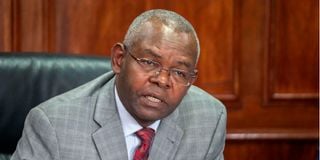Premium
CBK shocks borrowers with the highest rate in 11 years

Central Bank of Kenya Governor Kamau Thugge.
Kenyans should brace themselves for more expensive bank loans after the Central Bank of Kenya (CBK) increased its benchmark lending rate to the highest point in 11 years as it moved to curb inflation and support the battered shilling.
This is after the Monetary Policy Committee (MPC) increased the CBK rate to 12.5 percent from 10.5 percent, the highest since September 5, 2012, when the rate was at 13 percent.
The new rate will usher in a fresh round of upward repricing of loans, dealing a blow to borrowers who are already grappling with elevated prices of goods and services and new statutory deductions such as the housing levy that have combined to weaken their ability to service loans.
The rate hike is the third in the year and the fastest since November 1, 2011, when CBK surprised the market with a 5.5 percentage points rise in the rate from 11 percent to 16.5 percent.
Commercial banks' weighted average interest rates have been rising over time to hit 13.98 percent in September— the highest since May 2016 when the figure was at 18.22 percent. Many customers are currently paying rates above 18 percent since banks price in factors such as the risk of defaulting.
Bankers had advised the CBK to keep the rate unchanged at 10.5 percent as it has been since June 26 but the MPC opted to increase it, citing the need to control the weakening of the shilling against the dollar which has increased debt servicing costs and increased the spending on imports.
“The MPC noted that exchange rate depreciation continues to exert upward pressure on domestic prices thereby increasing the cost of living and reducing the purchasing power,” noted the MPC.
“The MPC therefore concluded that there is a need to adjust the monetary policy stance to address the pressure on the exchange rate and mitigate second round effects including from global prices.”
The MPC says of the 6.8 percent overall inflation posted in November, exchange rate depreciation contributed about three percentage points.
The upward review will however see banks increase the price of accessing loans in an economy where defaults are already at levels last seen 16 years ago when Kenya was dealing with the effects of post-election violence.
CBK data shows gross non-performing loans (NPLs)—the volume of loans on which interest and principal have not been paid for at least three months—hit Sh615.54 billion in September, marking three straight months of increasing defaults.
The Sh615.5 billion defaults against a loan book of Sh4.103 trillion at the end of September means the NPL ratio is at 15 percent—being closer to that of 15.4 percent that the sector posted in June 2007.
The NPL ratio hit 15.3 percent in October, pointing to the continued loan defaults that have forced lenders to set aside more money in anticipation of increased defaults.
Bankers, through their lobby, Kenya Bankers Association (KBA) had last week expressed fear that the rate hike will lead to mass defaults among borrowers given the situation in the economy.
“A further rate hike to tame potential inflationary pressures – if implemented fully by banks – would further escalate credit risk in the market and a build-up in non-performing loans with detrimental effects on the industry’s stability,” said KBA.
Since January, the shilling has shed over 23 percent of its value against the dollar, with CBK Governor Kamau Thugge recently telling Parliament the stock of external debt and debt service increased by Sh382.6 billion and Sh6.9 billion respectively in the four months to October on account of exchange rate depreciation. Treasury data shows the proportion of Kenya’s external debt denominated in US dollar was at 67.2 percent at the start of July while 21.3 percent, 3.9 percent, 5.1 percent, and 2.3 percent were in Euro, Yen, Yuan, and Sterling Pound respectively
Banks’ stock of NPLs has risen by Sh127.84 billion or 26.2 percent since January—a development that has spooked banks, forcing them to increase provisioning for loan defaults.
Nine-month unaudited results from top banks have shown an upward trend in the size of money being set aside in anticipation of defaults, eating into the profitability
CBK credit survey taken at the end of September shows 45 percent of the banks surveyed by the regulator indicated that NPLs were likely to rise in the fourth quarter ending December.
About 21 percent of the respondents said they expect the level of NPLs to remain constant while 34 percent expect the level of NPLs to fall.
The State is worried that the continuing weakening of the shilling and the rising interest rates amid sustained spending pressures could wreck its plan of achieving a 5.4 percent budget deficit in the current financial year and trim this to 4.4 percent of GDP in 2024/25 and further to 3.6 percent in 2026/27.
Apart from the debt servicing burden, taxpayers are also feeling the heat on imports such as fuel, processed food, and other finished goods and raw materials for manufacturing goods. This is filtered to consumers through elevated prices.





